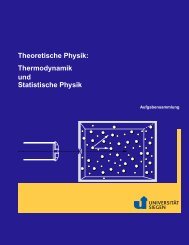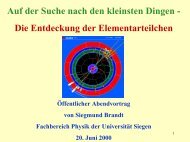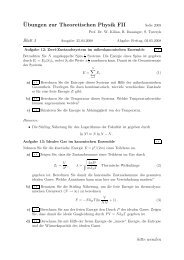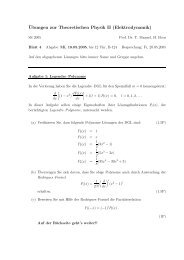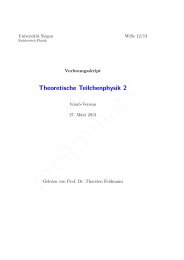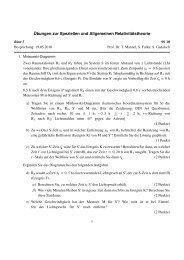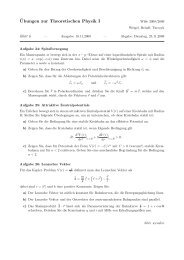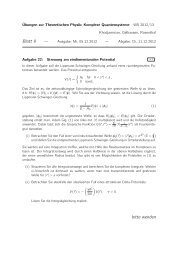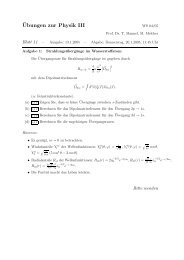Problems to Standard Model - Theoretische Physik 1 ...
Problems to Standard Model - Theoretische Physik 1 ...
Problems to Standard Model - Theoretische Physik 1 ...
Create successful ePaper yourself
Turn your PDF publications into a flip-book with our unique Google optimized e-Paper software.
<strong>Problems</strong> <strong>to</strong> <strong>Standard</strong> <strong>Model</strong> SS 2011<br />
Th. Mannel, T. Huber, S. Faller<br />
Sheet 7 — Handout: 27.05.2011 — Due: Friday, 03.06.2011<br />
Problem 22: The -<strong>Model</strong><br />
The so called -model for four real scalar fields , j .j D 1; 2; 3/ and two Dirac-fields 1 , 2 is<br />
defined through the Lagrangian density<br />
5 P<br />
ˇ D 1 2<br />
3X<br />
.@ j /.@ j / C 1 2X<br />
2 .@ /.@ / C<br />
j D1<br />
j D1<br />
N j i =@ j V .; i / ˇint ;<br />
where<br />
V .; i / D 1 2 2 2 C<br />
ˇint D g<br />
2X<br />
j;lD1<br />
3X<br />
j D1<br />
2 j<br />
N j<br />
ı jl C i<br />
<br />
C <br />
2 C<br />
4<br />
3X<br />
2<br />
j 2 ; with 2 < 0 ; > 0 ;<br />
j D1<br />
3X<br />
<br />
k . k / jl 5<br />
kD1<br />
l ; k : Pauli matrices :<br />
a) Prove the invariance under the infinitesimal global SU.2/ symmetry transformations,<br />
7 ! ;<br />
j 7 ! j C jkl˛k l ;<br />
2X<br />
<br />
i<br />
3X<br />
<br />
k 7 ! ı kl ˛j . j / kl<br />
2<br />
lD1<br />
j D1<br />
l ;<br />
and calculate the associated Noether currents.<br />
b) Verify that the Lagrangian density is also invariant under the global transformations,<br />
3X<br />
7 ! C ˛j j ;<br />
j D1<br />
j 7 ! j ˛j ;<br />
2X<br />
<br />
k 7 ! ı kl C i 2<br />
lD1<br />
3X<br />
<br />
˛j . j / kl 5<br />
j D1<br />
l :<br />
Compute the corresponding Noether currents.
Problem 23: Two Particle Phase Space<br />
a) Show that<br />
Z<br />
d 3 Z<br />
k d 3`<br />
.2/ 3 2k 0 .2/ 3 2`0<br />
.2/ 4 ı .4/ .q k `/ D 1<br />
8q 2 q2 ; m 2 k ; m2` q<br />
0 q 2 .m k C m`/ 2 ;<br />
where m 2 1 ; m2 2 ; q<br />
m2 3 D m 4 1 C m4 2 C m4 3<br />
2m 2 1 m2 2<br />
2m 2 1 m2 3<br />
2m 2 2 m2 3 .<br />
Compute the limiting cases<br />
Hint:<br />
i) m k D m ; m` D m ;<br />
ii) m k D 0 ; m` D m ;<br />
iii) m k D 0 ; m` D 0 :<br />
Use the result of problem 9b).<br />
5 P<br />
b) Now use this result, <strong>to</strong> compute the vec<strong>to</strong>r and tensor integrals<br />
Z<br />
d 3 Z<br />
k d 3`<br />
.2/ 3 2k 0 .2/ 3 k˛.2/ 4 ı .4/ .q k `/ and<br />
2`0<br />
Z<br />
d 3 Z<br />
k d 3`<br />
k˛`ˇ .2/ 3 2k 0 .2/ 3 .2/ 4 ı .4/ .q k `/ :<br />
2`0<br />
For simplicity put the masses m` D m k D 0.<br />
Hint:<br />
Show that the integral has <strong>to</strong> be covariant under Lorentz transformations. Which Lorentz<br />
vec<strong>to</strong>rs and tensors are available <strong>to</strong> construct the needed Lorentz structure?<br />
Make a general Ansatz, and determine the coefficients by appropriate projections.<br />
Problem 24: The Dirac Field<br />
Consider the Dirac field, as given in the lecture<br />
˛.x/ D X Z<br />
d 3 p<br />
h<br />
.2/ 3 2p 0 a.p; s/u˛.p; s/e ipx C b .p; s/v˛.p; s/e ipxi<br />
sD˙ 1<br />
2<br />
N ˇ .x/ D X<br />
sD˙ 1<br />
2<br />
Z<br />
d 3 p<br />
h<br />
.2/ 3 2p 0 a .p; s/ Nuˇ .p; s/e ipx C b.p; s/ Nvˇ .p; s/e ipxi :<br />
a) An alternative way <strong>to</strong> compute the propaga<strong>to</strong>r of the Dirac field is by considering the following<br />
matrix element,<br />
˝0<br />
ˇˇT<br />
<br />
˛.x/ N ˇ .y/ ˇˇ 0˛<br />
:<br />
5 P<br />
please turn over!
The symbol T Œ: : : denotes the time-ordered product, which means<br />
˝0<br />
ˇˇT ˛.x/ N ˇ .y/ ˇˇ 0˛<br />
D<br />
˝0<br />
ˇˇ ˛.x/ N ˇ .y/ˇˇ 0˛<br />
x<br />
0<br />
y 0 ˝0 ˇˇ N ˇ .y/ ˛.x/ˇˇ 0˛<br />
y<br />
0<br />
x 0 ;<br />
where the minus sign is due <strong>to</strong> the fact that the fermion fields anticommute.<br />
Show that this leads <strong>to</strong> the Dirac propaga<strong>to</strong>r in the following form,<br />
˝0<br />
ˇˇT<br />
<br />
˛.x/ N ˇ .y/ ˇˇ Z<br />
0˛<br />
D<br />
d 4 p<br />
.2/ 4 <br />
i QG.p/ ˛ˇ e ip.x y/ ;<br />
where i QG.p/ is the Dirac propaga<strong>to</strong>r in momentum space as given in the lecture.<br />
Hint:<br />
Use the following representation for the -step function<br />
.z/ D 1 Z 1<br />
d eiz<br />
2i 1 i :<br />
b) Show that the annihilation opera<strong>to</strong>rs a.p; r/ and b.p; r/ can be written as the following integrals<br />
over the field .x/.<br />
Z<br />
a.p; r/ D d 3 x u ˛.p; r/ ˛.x/ e ipx ;<br />
Z<br />
b.p; r/ D d 3 x N ˛.x/ 0˛ˇ vˇ .p; r/ e ipx :



